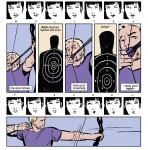Comic books are everywhere – Marvel and DC Comics are mining decades of story lines for a huge slate of movies and television shows. But comics are more than a source to be mined for superhero blockbusters. New creators are dealing with issues every month in ways that couldn’t be done in other formats – issues of comic books.
Indie comics are cool. But there’s a lot of passion in superhero comics – people trying to tell the best stories that they possibly can in these worlds.
Most of the people writing and drawing superheroes are fans. You don’t get the job of writing “Batman” if you haven’t read “Batman.” The upside of working in the DC or Marvel universe is that you have decades of continuous backstory, which sets the stakes and informs the characters. The downside is that reconciling previous events into a timeline can be difficult and messy.
Like that one time when Spider-Man sold his marriage to the devil, and that time when Green Lantern murdered all of the other Green Lanterns, died, became God’s Spirit of Vengeance and eventually came back. Hawkman’s history as no less than four distinct characters made him too toxic to write for. The Flash has the advantage of being built around a central theme of heroic legacies, especially during Mark Waid’s run.
People always want to feel like the story that they’re reading matters. In a self-contained series, it’s easy to place characters in peril, but in long-running superhero comics, it’s much harder. Twenty years ago, Superman died and came back, and since then nobody’s bought that a death will stick for more than a few years. These companies resort to large events to raise the stakes.
In April and May, during the publisher’s move from New York to Burbank, DC’s big crossover event “Convergence” will feature characters from decades-old settings fighting each other at the behest of Brainiac, an alien robot who collects cities from multiple universes. Marvel’s “Secret Wars,” starting in May, features characters from across their multiverse fighting on a patchwork Battleworld assembled from destroyed earths. These events are nearly incomprehensible to those not steeped in lore, and they’ll inevitably reset to status quo afterwards.
“Secret Wars” builds on Jonathan Hickman’s run writing “Avengers,” which is about a bigger team taking on interstellar threats, and “New Avengers” about a secret Illuminati of Marvel’s smart guys – including Iron Man, X-Men’s Beast and Mister Fantastic. They make moral compromises to stop the multiverse from dying.
Both are suspiciously similar consequences of different stories set in alternate universes, like “Spider-Gwen,” or “Superman: Red Son,” about a world where baby Superman lands in Soviet Ukraine and is mentored by Stalin. These tend to be instantly approachable without any background, and since they’re set in a world that won’t be revisited, they’re free to make big changes.
“Secret Wars” will also spell the end of Marvel’s 15-year-old Ultimate Universe, which reinterpreted characters in a more “modern” setting, freed from the shackles of continuity. Brian Michael Bendis’ long-running “Ultimate Spider-Man” was the flagship of the line, telling Peter Parker’s story until his death and his replacement by black teen Miles Morales. Other books were uneven – eventually, the differences that separated Ultimate from mainline Marvel muddled. What was once a fresh take rotted for a decade.
There are really two ways to deal with continuity. One is a measured approach, more friendly to new readers, where the backstory informs but doesn’t overwhelm. Matt Fraction’s and David Aja’s excellent “Hawkeye” is framed as what the archer does at home when he isn’t an Avenger. Elements of his past show up over time, like Kate Bishop, also codenamed Hawkeye, but they’re all explained succinctly. This is the way most comics should operate – in a way that’s conducive to new readers. Just go read Hawkeye right now.
The other way is to embrace it. Grant Morrison does one main schtick – metatextual reading of superhero-as-mythological-hero. In his “Batman” and “All-Star Superman,” he relies on the idea that these superhero comics are all ongoing legends.
Morrison’s current “The Multiversity” miniseries builds on this idea. Each story covers a separate crisis across different worlds, each with a different genre and artist, all communicating by reading each other’s stories in prophetic comic books. It’s steeped in references to characters and stories decades deep and is best read with annotations handy. It uses these references carefully.
Really, the thing to do is the same thing you do as a well-informed consumer of any media – find stuff you like by good authors and keep reading that, rather than necessarily reading for a specific character. The character will inevitably change under different pens. Communicating these character’s histories in a coherent way is a part of good comic book writing.
Continuity should be a breathable coat, not a straightjacket. This continuity coat should have pockets filled with interesting, shiny objects that keep the reader interested, rather than heavy rocks that weigh them down.
Can someone just explain Hawkeye’s backstory? Email Greenberg at jogreenberg@media.ucla.edu.
